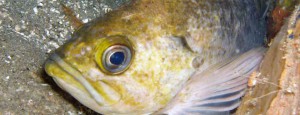Study Species
- it is one of the most abundant shallow-dwelling reef fishes in central California and the number of young each mother produces is very high (tens of thousands of larvae per spawning event). Therefore, we can more easily sample large numbers of both young and adults.
- adults are limited to shallow depths (< 20 m) such that they can be caught by hook-and-line fishing from the surface, sampled and returned unharmed. We can also estimate the size of adult populations using SCUBA diver surveys.
- adults have small home ranges (600 sq. meters). Therefore, when we identify the parent of a juvenile we collect, we know exactly where that juvenile was born. Also, genetically-identified adults can consistently contribute to larval production for multiple years from the same local area.
- it has a relatively short spawning period and larval duration (2 months) relative to other rockfishes (e.g., 3-4 months) and recruitment corresponds with upwelling relaxation events, suggesting that larvae may not disperse far from shore, potentially facilitating retention and increasing recapture probabilities of genetically-tagged larvae in our study region.
- the pelagic juveniles settle in easily accessible kelp forest canopies and SMURFs (larval collectors) in large numbers, making collection of large numbers of settling juveniles possible even in years of low rockfish recruitment.
Taken together, these life history characteristics are ideal for sampling of substantial proportions of the adult spawners, estimating the proportion of adults whose offspring are genetically tagged at a given site, collecting recruits, and increasing the likelihood of recovery and detection of genetically-tagged recruits. Additionally they are important to the recreational and nearshore live-fish fishery along the California coast and targeted for protection by California’s recently established network of MPAs.
